Unilever PLC: An Analysis of the Marketing Mix Elements
VerifiedAdded on 2023/06/06
|9
|2767
|76
Report
AI Summary
This report provides a detailed analysis of Unilever's marketing mix, focusing on the 7Ps framework (Product, Price, Place, Promotion, People, Process, and Physical Evidence). The introduction provides an overview of Unilever PLC, its structure, and its operations, particularly in India. The report delves into each element of the marketing mix, examining Unilever's strategies for distribution, promotion, pricing, and product development. It explores how Unilever adapts its strategies to the Indian market, including its distribution network, promotional campaigns, and pricing policies. Furthermore, the report analyzes the role of people, processes, and physical evidence in Unilever's marketing approach. The conclusion summarizes the importance of the 7Ps in achieving long-term targets and sustaining a competitive edge in both local and global markets. The report highlights Unilever's customer-centric approach and its ability to adapt its strategies to meet the needs of its target audience.
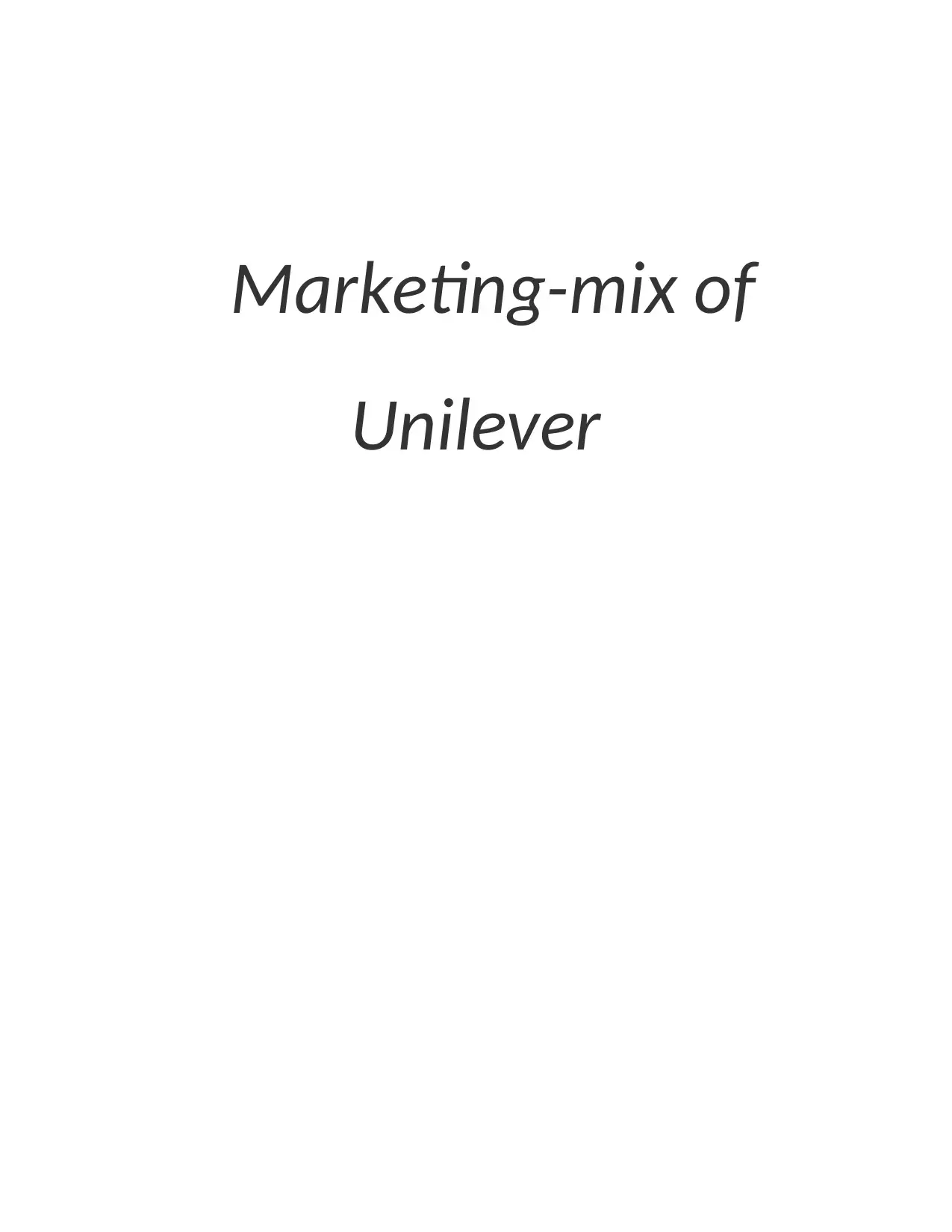
Marketing-mix of
Unilever
Unilever
Paraphrase This Document
Need a fresh take? Get an instant paraphrase of this document with our AI Paraphraser
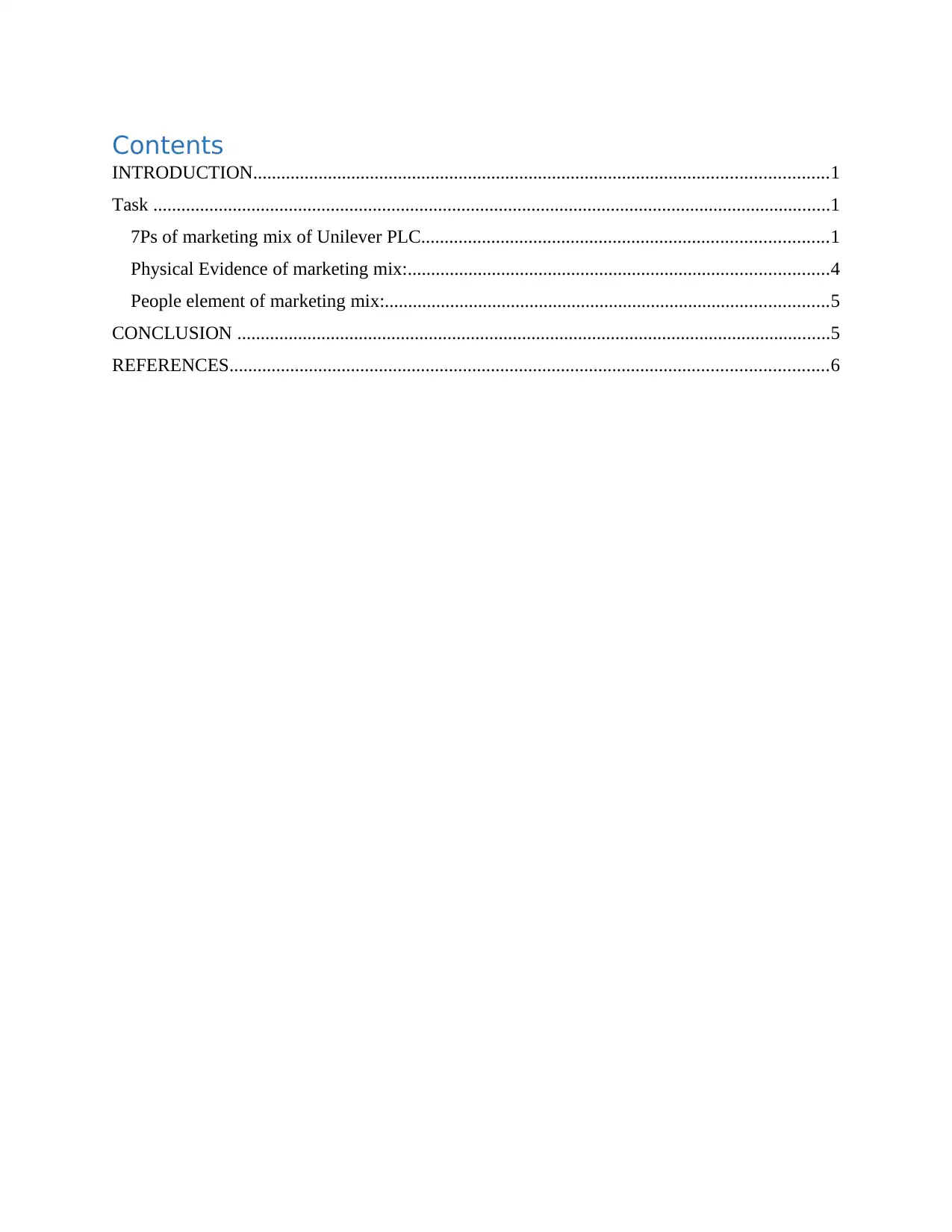
Contents
INTRODUCTION...........................................................................................................................1
Task .................................................................................................................................................1
7Ps of marketing mix of Unilever PLC.......................................................................................1
Physical Evidence of marketing mix:..........................................................................................4
People element of marketing mix:...............................................................................................5
CONCLUSION ...............................................................................................................................5
REFERENCES................................................................................................................................6
INTRODUCTION...........................................................................................................................1
Task .................................................................................................................................................1
7Ps of marketing mix of Unilever PLC.......................................................................................1
Physical Evidence of marketing mix:..........................................................................................4
People element of marketing mix:...............................................................................................5
CONCLUSION ...............................................................................................................................5
REFERENCES................................................................................................................................6
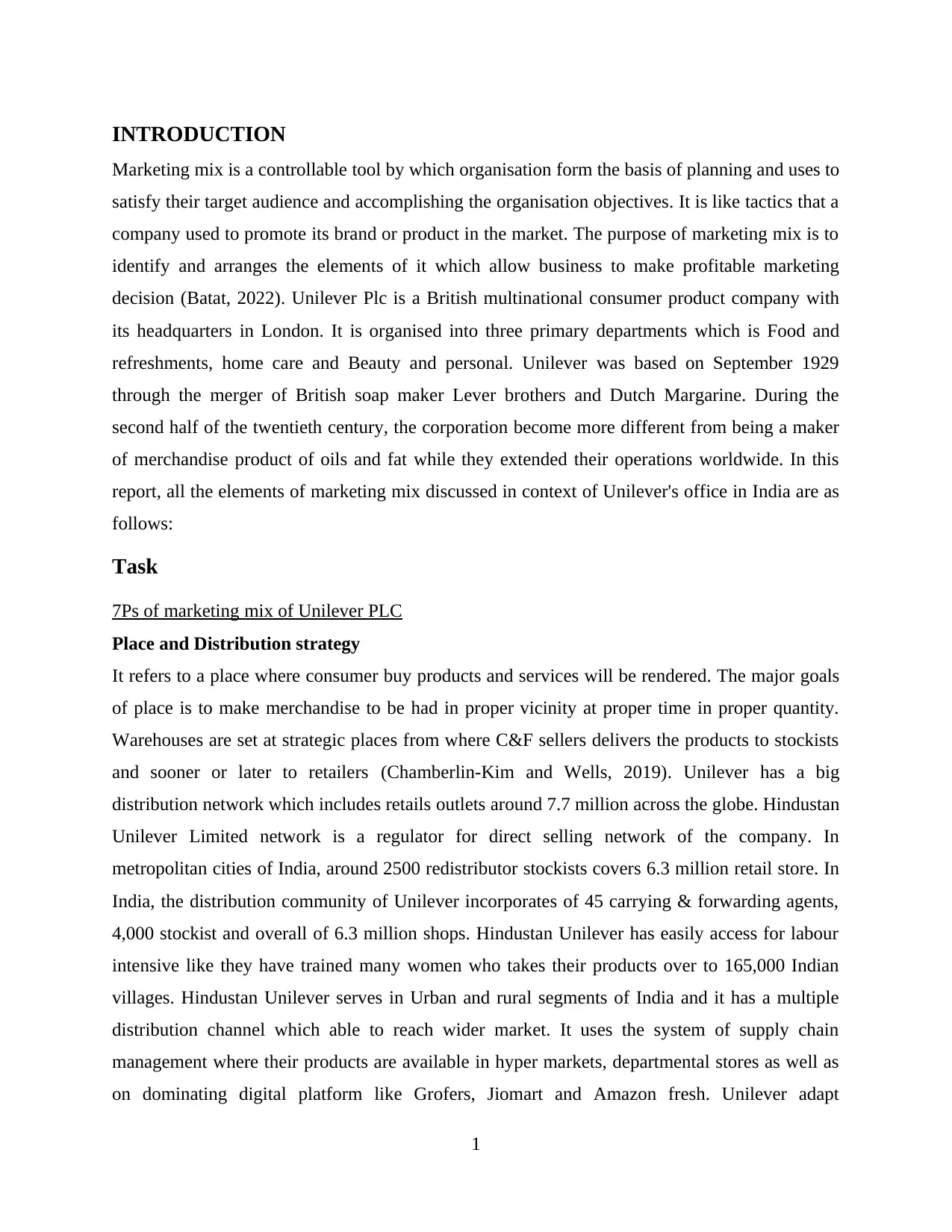
INTRODUCTION
Marketing mix is a controllable tool by which organisation form the basis of planning and uses to
satisfy their target audience and accomplishing the organisation objectives. It is like tactics that a
company used to promote its brand or product in the market. The purpose of marketing mix is to
identify and arranges the elements of it which allow business to make profitable marketing
decision (Batat, 2022). Unilever Plc is a British multinational consumer product company with
its headquarters in London. It is organised into three primary departments which is Food and
refreshments, home care and Beauty and personal. Unilever was based on September 1929
through the merger of British soap maker Lever brothers and Dutch Margarine. During the
second half of the twentieth century, the corporation become more different from being a maker
of merchandise product of oils and fat while they extended their operations worldwide. In this
report, all the elements of marketing mix discussed in context of Unilever's office in India are as
follows:
Task
7Ps of marketing mix of Unilever PLC
Place and Distribution strategy
It refers to a place where consumer buy products and services will be rendered. The major goals
of place is to make merchandise to be had in proper vicinity at proper time in proper quantity.
Warehouses are set at strategic places from where C&F sellers delivers the products to stockists
and sooner or later to retailers (Chamberlin-Kim and Wells, 2019). Unilever has a big
distribution network which includes retails outlets around 7.7 million across the globe. Hindustan
Unilever Limited network is a regulator for direct selling network of the company. In
metropolitan cities of India, around 2500 redistributor stockists covers 6.3 million retail store. In
India, the distribution community of Unilever incorporates of 45 carrying & forwarding agents,
4,000 stockist and overall of 6.3 million shops. Hindustan Unilever has easily access for labour
intensive like they have trained many women who takes their products over to 165,000 Indian
villages. Hindustan Unilever serves in Urban and rural segments of India and it has a multiple
distribution channel which able to reach wider market. It uses the system of supply chain
management where their products are available in hyper markets, departmental stores as well as
on dominating digital platform like Grofers, Jiomart and Amazon fresh. Unilever adapt
1
Marketing mix is a controllable tool by which organisation form the basis of planning and uses to
satisfy their target audience and accomplishing the organisation objectives. It is like tactics that a
company used to promote its brand or product in the market. The purpose of marketing mix is to
identify and arranges the elements of it which allow business to make profitable marketing
decision (Batat, 2022). Unilever Plc is a British multinational consumer product company with
its headquarters in London. It is organised into three primary departments which is Food and
refreshments, home care and Beauty and personal. Unilever was based on September 1929
through the merger of British soap maker Lever brothers and Dutch Margarine. During the
second half of the twentieth century, the corporation become more different from being a maker
of merchandise product of oils and fat while they extended their operations worldwide. In this
report, all the elements of marketing mix discussed in context of Unilever's office in India are as
follows:
Task
7Ps of marketing mix of Unilever PLC
Place and Distribution strategy
It refers to a place where consumer buy products and services will be rendered. The major goals
of place is to make merchandise to be had in proper vicinity at proper time in proper quantity.
Warehouses are set at strategic places from where C&F sellers delivers the products to stockists
and sooner or later to retailers (Chamberlin-Kim and Wells, 2019). Unilever has a big
distribution network which includes retails outlets around 7.7 million across the globe. Hindustan
Unilever Limited network is a regulator for direct selling network of the company. In
metropolitan cities of India, around 2500 redistributor stockists covers 6.3 million retail store. In
India, the distribution community of Unilever incorporates of 45 carrying & forwarding agents,
4,000 stockist and overall of 6.3 million shops. Hindustan Unilever has easily access for labour
intensive like they have trained many women who takes their products over to 165,000 Indian
villages. Hindustan Unilever serves in Urban and rural segments of India and it has a multiple
distribution channel which able to reach wider market. It uses the system of supply chain
management where their products are available in hyper markets, departmental stores as well as
on dominating digital platform like Grofers, Jiomart and Amazon fresh. Unilever adapt
1
⊘ This is a preview!⊘
Do you want full access?
Subscribe today to unlock all pages.

Trusted by 1+ million students worldwide
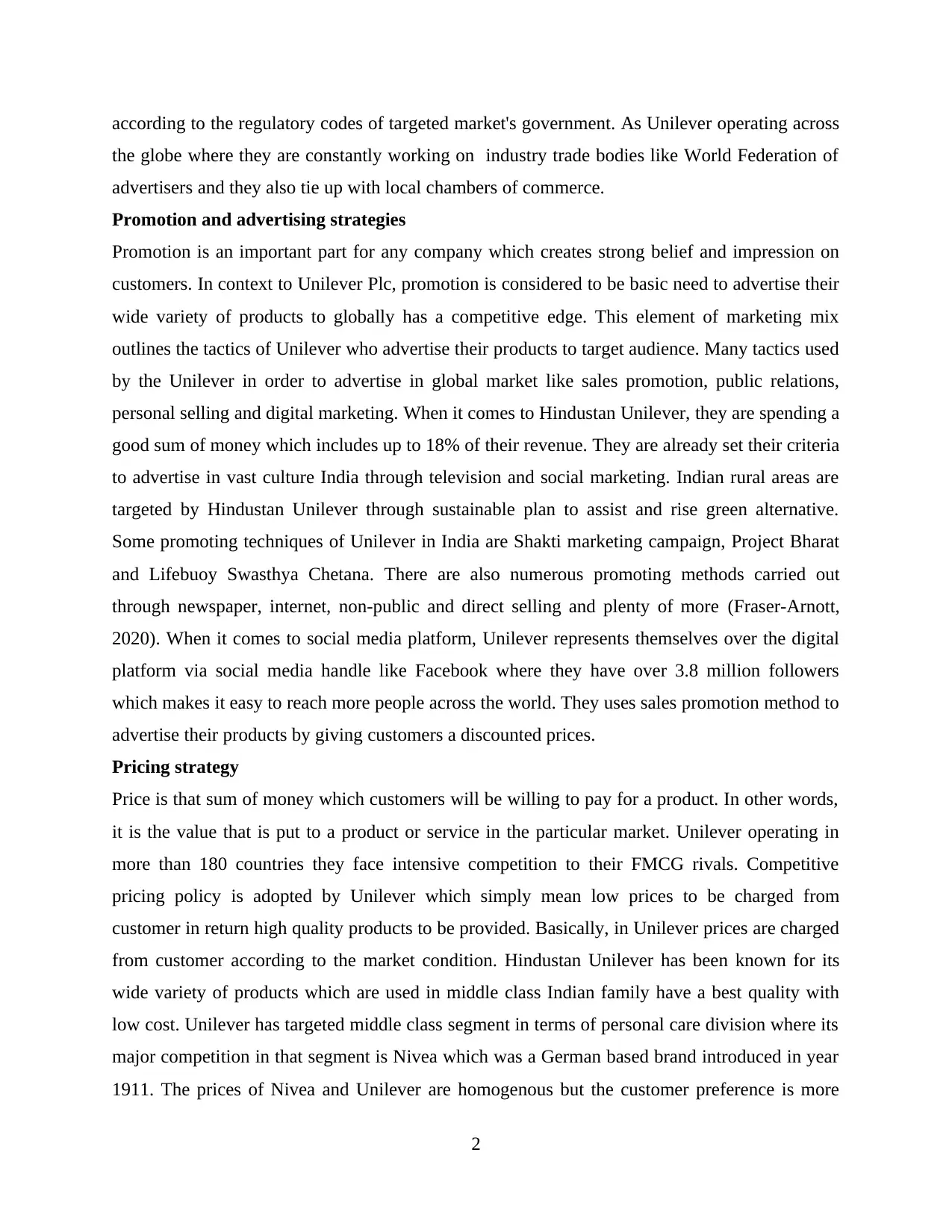
according to the regulatory codes of targeted market's government. As Unilever operating across
the globe where they are constantly working on industry trade bodies like World Federation of
advertisers and they also tie up with local chambers of commerce.
Promotion and advertising strategies
Promotion is an important part for any company which creates strong belief and impression on
customers. In context to Unilever Plc, promotion is considered to be basic need to advertise their
wide variety of products to globally has a competitive edge. This element of marketing mix
outlines the tactics of Unilever who advertise their products to target audience. Many tactics used
by the Unilever in order to advertise in global market like sales promotion, public relations,
personal selling and digital marketing. When it comes to Hindustan Unilever, they are spending a
good sum of money which includes up to 18% of their revenue. They are already set their criteria
to advertise in vast culture India through television and social marketing. Indian rural areas are
targeted by Hindustan Unilever through sustainable plan to assist and rise green alternative.
Some promoting techniques of Unilever in India are Shakti marketing campaign, Project Bharat
and Lifebuoy Swasthya Chetana. There are also numerous promoting methods carried out
through newspaper, internet, non-public and direct selling and plenty of more (Fraser-Arnott,
2020). When it comes to social media platform, Unilever represents themselves over the digital
platform via social media handle like Facebook where they have over 3.8 million followers
which makes it easy to reach more people across the world. They uses sales promotion method to
advertise their products by giving customers a discounted prices.
Pricing strategy
Price is that sum of money which customers will be willing to pay for a product. In other words,
it is the value that is put to a product or service in the particular market. Unilever operating in
more than 180 countries they face intensive competition to their FMCG rivals. Competitive
pricing policy is adopted by Unilever which simply mean low prices to be charged from
customer in return high quality products to be provided. Basically, in Unilever prices are charged
from customer according to the market condition. Hindustan Unilever has been known for its
wide variety of products which are used in middle class Indian family have a best quality with
low cost. Unilever has targeted middle class segment in terms of personal care division where its
major competition in that segment is Nivea which was a German based brand introduced in year
1911. The prices of Nivea and Unilever are homogenous but the customer preference is more
2
the globe where they are constantly working on industry trade bodies like World Federation of
advertisers and they also tie up with local chambers of commerce.
Promotion and advertising strategies
Promotion is an important part for any company which creates strong belief and impression on
customers. In context to Unilever Plc, promotion is considered to be basic need to advertise their
wide variety of products to globally has a competitive edge. This element of marketing mix
outlines the tactics of Unilever who advertise their products to target audience. Many tactics used
by the Unilever in order to advertise in global market like sales promotion, public relations,
personal selling and digital marketing. When it comes to Hindustan Unilever, they are spending a
good sum of money which includes up to 18% of their revenue. They are already set their criteria
to advertise in vast culture India through television and social marketing. Indian rural areas are
targeted by Hindustan Unilever through sustainable plan to assist and rise green alternative.
Some promoting techniques of Unilever in India are Shakti marketing campaign, Project Bharat
and Lifebuoy Swasthya Chetana. There are also numerous promoting methods carried out
through newspaper, internet, non-public and direct selling and plenty of more (Fraser-Arnott,
2020). When it comes to social media platform, Unilever represents themselves over the digital
platform via social media handle like Facebook where they have over 3.8 million followers
which makes it easy to reach more people across the world. They uses sales promotion method to
advertise their products by giving customers a discounted prices.
Pricing strategy
Price is that sum of money which customers will be willing to pay for a product. In other words,
it is the value that is put to a product or service in the particular market. Unilever operating in
more than 180 countries they face intensive competition to their FMCG rivals. Competitive
pricing policy is adopted by Unilever which simply mean low prices to be charged from
customer in return high quality products to be provided. Basically, in Unilever prices are charged
from customer according to the market condition. Hindustan Unilever has been known for its
wide variety of products which are used in middle class Indian family have a best quality with
low cost. Unilever has targeted middle class segment in terms of personal care division where its
major competition in that segment is Nivea which was a German based brand introduced in year
1911. The prices of Nivea and Unilever are homogenous but the customer preference is more
2
Paraphrase This Document
Need a fresh take? Get an instant paraphrase of this document with our AI Paraphraser
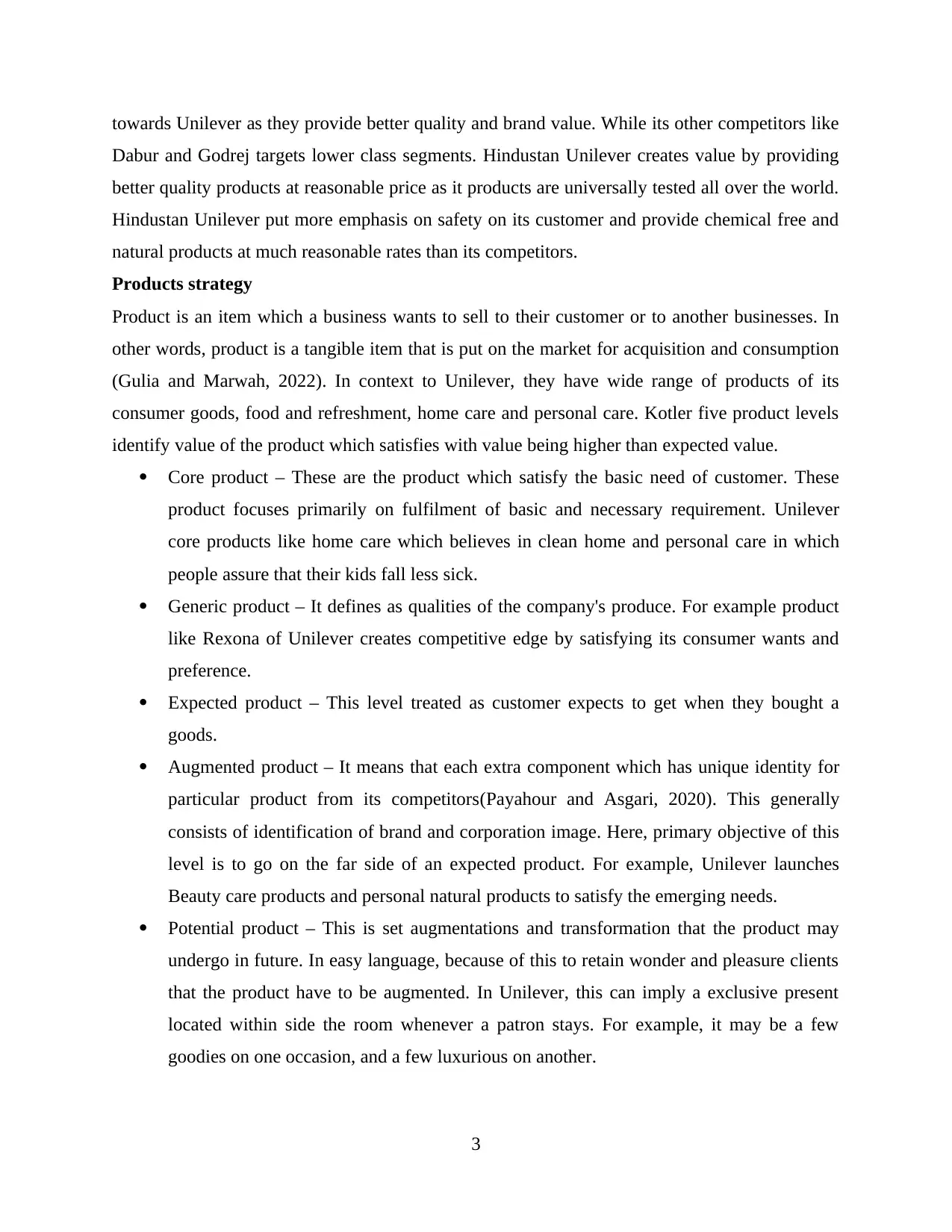
towards Unilever as they provide better quality and brand value. While its other competitors like
Dabur and Godrej targets lower class segments. Hindustan Unilever creates value by providing
better quality products at reasonable price as it products are universally tested all over the world.
Hindustan Unilever put more emphasis on safety on its customer and provide chemical free and
natural products at much reasonable rates than its competitors.
Products strategy
Product is an item which a business wants to sell to their customer or to another businesses. In
other words, product is a tangible item that is put on the market for acquisition and consumption
(Gulia and Marwah, 2022). In context to Unilever, they have wide range of products of its
consumer goods, food and refreshment, home care and personal care. Kotler five product levels
identify value of the product which satisfies with value being higher than expected value.
Core product – These are the product which satisfy the basic need of customer. These
product focuses primarily on fulfilment of basic and necessary requirement. Unilever
core products like home care which believes in clean home and personal care in which
people assure that their kids fall less sick.
Generic product – It defines as qualities of the company's produce. For example product
like Rexona of Unilever creates competitive edge by satisfying its consumer wants and
preference.
Expected product – This level treated as customer expects to get when they bought a
goods.
Augmented product – It means that each extra component which has unique identity for
particular product from its competitors(Payahour and Asgari, 2020). This generally
consists of identification of brand and corporation image. Here, primary objective of this
level is to go on the far side of an expected product. For example, Unilever launches
Beauty care products and personal natural products to satisfy the emerging needs.
Potential product – This is set augmentations and transformation that the product may
undergo in future. In easy language, because of this to retain wonder and pleasure clients
that the product have to be augmented. In Unilever, this can imply a exclusive present
located within side the room whenever a patron stays. For example, it may be a few
goodies on one occasion, and a few luxurious on another.
3
Dabur and Godrej targets lower class segments. Hindustan Unilever creates value by providing
better quality products at reasonable price as it products are universally tested all over the world.
Hindustan Unilever put more emphasis on safety on its customer and provide chemical free and
natural products at much reasonable rates than its competitors.
Products strategy
Product is an item which a business wants to sell to their customer or to another businesses. In
other words, product is a tangible item that is put on the market for acquisition and consumption
(Gulia and Marwah, 2022). In context to Unilever, they have wide range of products of its
consumer goods, food and refreshment, home care and personal care. Kotler five product levels
identify value of the product which satisfies with value being higher than expected value.
Core product – These are the product which satisfy the basic need of customer. These
product focuses primarily on fulfilment of basic and necessary requirement. Unilever
core products like home care which believes in clean home and personal care in which
people assure that their kids fall less sick.
Generic product – It defines as qualities of the company's produce. For example product
like Rexona of Unilever creates competitive edge by satisfying its consumer wants and
preference.
Expected product – This level treated as customer expects to get when they bought a
goods.
Augmented product – It means that each extra component which has unique identity for
particular product from its competitors(Payahour and Asgari, 2020). This generally
consists of identification of brand and corporation image. Here, primary objective of this
level is to go on the far side of an expected product. For example, Unilever launches
Beauty care products and personal natural products to satisfy the emerging needs.
Potential product – This is set augmentations and transformation that the product may
undergo in future. In easy language, because of this to retain wonder and pleasure clients
that the product have to be augmented. In Unilever, this can imply a exclusive present
located within side the room whenever a patron stays. For example, it may be a few
goodies on one occasion, and a few luxurious on another.
3
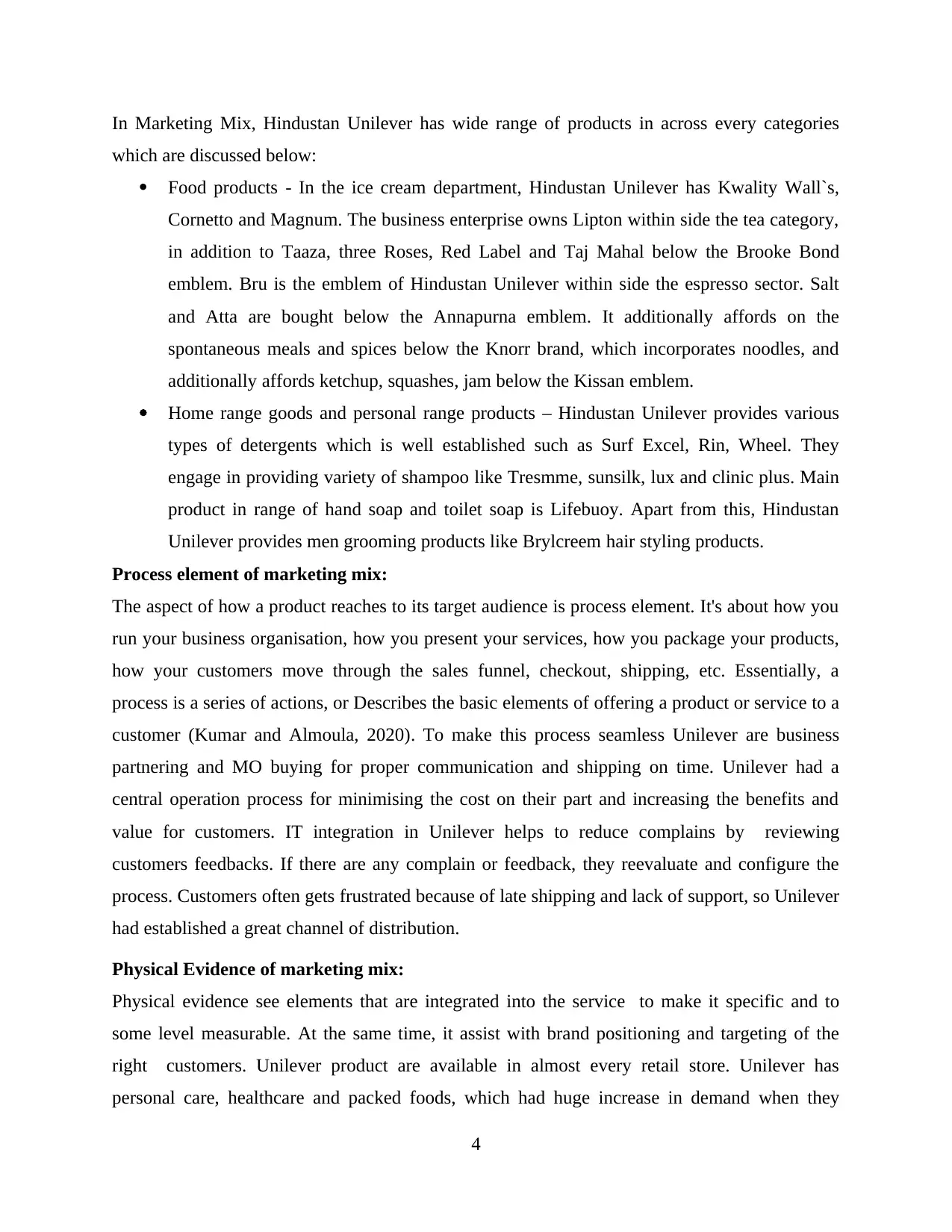
In Marketing Mix, Hindustan Unilever has wide range of products in across every categories
which are discussed below:
Food products - In the ice cream department, Hindustan Unilever has Kwality Wall`s,
Cornetto and Magnum. The business enterprise owns Lipton within side the tea category,
in addition to Taaza, three Roses, Red Label and Taj Mahal below the Brooke Bond
emblem. Bru is the emblem of Hindustan Unilever within side the espresso sector. Salt
and Atta are bought below the Annapurna emblem. It additionally affords on the
spontaneous meals and spices below the Knorr brand, which incorporates noodles, and
additionally affords ketchup, squashes, jam below the Kissan emblem.
Home range goods and personal range products – Hindustan Unilever provides various
types of detergents which is well established such as Surf Excel, Rin, Wheel. They
engage in providing variety of shampoo like Tresmme, sunsilk, lux and clinic plus. Main
product in range of hand soap and toilet soap is Lifebuoy. Apart from this, Hindustan
Unilever provides men grooming products like Brylcreem hair styling products.
Process element of marketing mix:
The aspect of how a product reaches to its target audience is process element. It's about how you
run your business organisation, how you present your services, how you package your products,
how your customers move through the sales funnel, checkout, shipping, etc. Essentially, a
process is a series of actions, or Describes the basic elements of offering a product or service to a
customer (Kumar and Almoula, 2020). To make this process seamless Unilever are business
partnering and MO buying for proper communication and shipping on time. Unilever had a
central operation process for minimising the cost on their part and increasing the benefits and
value for customers. IT integration in Unilever helps to reduce complains by reviewing
customers feedbacks. If there are any complain or feedback, they reevaluate and configure the
process. Customers often gets frustrated because of late shipping and lack of support, so Unilever
had established a great channel of distribution.
Physical Evidence of marketing mix:
Physical evidence see elements that are integrated into the service to make it specific and to
some level measurable. At the same time, it assist with brand positioning and targeting of the
right customers. Unilever product are available in almost every retail store. Unilever has
personal care, healthcare and packed foods, which had huge increase in demand when they
4
which are discussed below:
Food products - In the ice cream department, Hindustan Unilever has Kwality Wall`s,
Cornetto and Magnum. The business enterprise owns Lipton within side the tea category,
in addition to Taaza, three Roses, Red Label and Taj Mahal below the Brooke Bond
emblem. Bru is the emblem of Hindustan Unilever within side the espresso sector. Salt
and Atta are bought below the Annapurna emblem. It additionally affords on the
spontaneous meals and spices below the Knorr brand, which incorporates noodles, and
additionally affords ketchup, squashes, jam below the Kissan emblem.
Home range goods and personal range products – Hindustan Unilever provides various
types of detergents which is well established such as Surf Excel, Rin, Wheel. They
engage in providing variety of shampoo like Tresmme, sunsilk, lux and clinic plus. Main
product in range of hand soap and toilet soap is Lifebuoy. Apart from this, Hindustan
Unilever provides men grooming products like Brylcreem hair styling products.
Process element of marketing mix:
The aspect of how a product reaches to its target audience is process element. It's about how you
run your business organisation, how you present your services, how you package your products,
how your customers move through the sales funnel, checkout, shipping, etc. Essentially, a
process is a series of actions, or Describes the basic elements of offering a product or service to a
customer (Kumar and Almoula, 2020). To make this process seamless Unilever are business
partnering and MO buying for proper communication and shipping on time. Unilever had a
central operation process for minimising the cost on their part and increasing the benefits and
value for customers. IT integration in Unilever helps to reduce complains by reviewing
customers feedbacks. If there are any complain or feedback, they reevaluate and configure the
process. Customers often gets frustrated because of late shipping and lack of support, so Unilever
had established a great channel of distribution.
Physical Evidence of marketing mix:
Physical evidence see elements that are integrated into the service to make it specific and to
some level measurable. At the same time, it assist with brand positioning and targeting of the
right customers. Unilever product are available in almost every retail store. Unilever has
personal care, healthcare and packed foods, which had huge increase in demand when they
4
⊘ This is a preview!⊘
Do you want full access?
Subscribe today to unlock all pages.

Trusted by 1+ million students worldwide
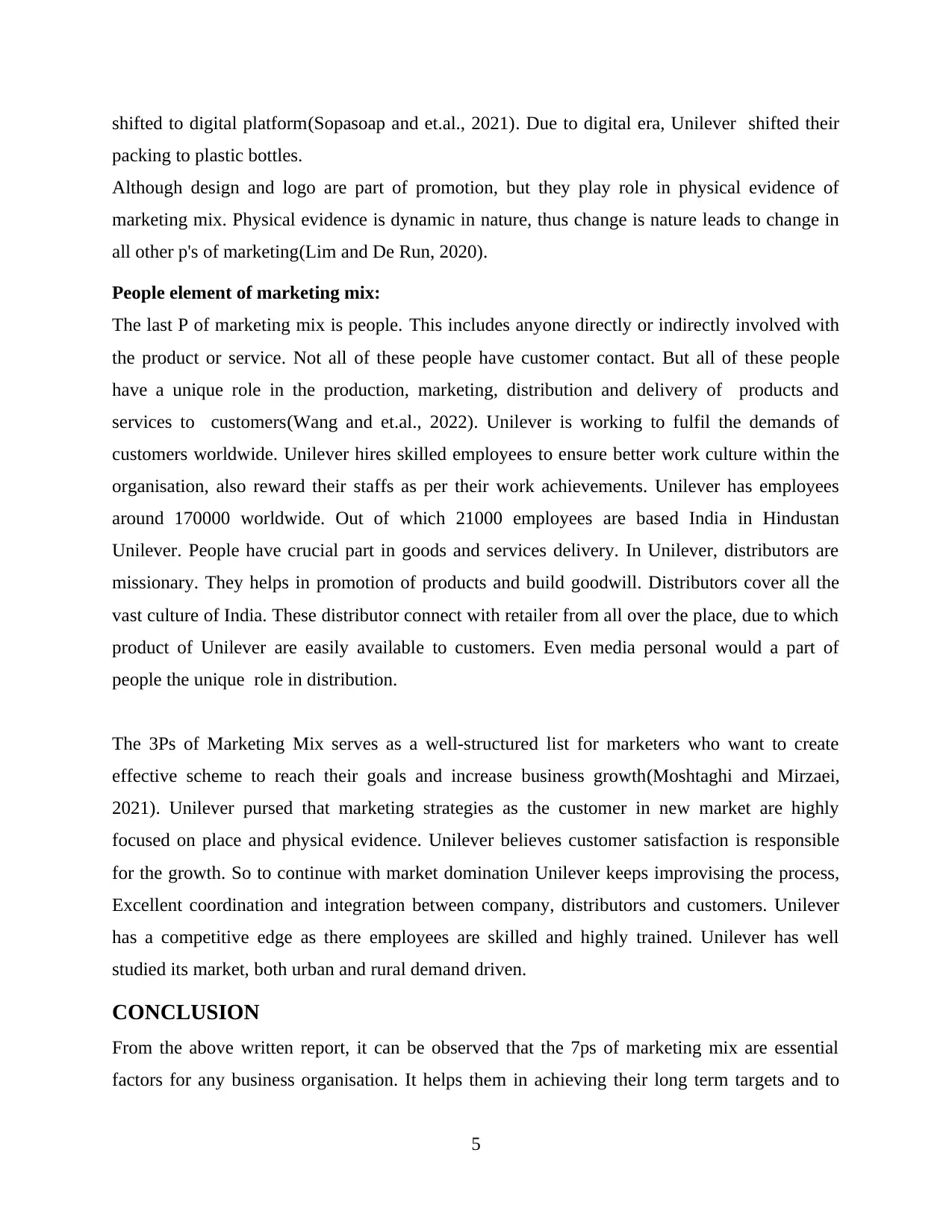
shifted to digital platform(Sopasoap and et.al., 2021). Due to digital era, Unilever shifted their
packing to plastic bottles.
Although design and logo are part of promotion, but they play role in physical evidence of
marketing mix. Physical evidence is dynamic in nature, thus change is nature leads to change in
all other p's of marketing(Lim and De Run, 2020).
People element of marketing mix:
The last P of marketing mix is people. This includes anyone directly or indirectly involved with
the product or service. Not all of these people have customer contact. But all of these people
have a unique role in the production, marketing, distribution and delivery of products and
services to customers(Wang and et.al., 2022). Unilever is working to fulfil the demands of
customers worldwide. Unilever hires skilled employees to ensure better work culture within the
organisation, also reward their staffs as per their work achievements. Unilever has employees
around 170000 worldwide. Out of which 21000 employees are based India in Hindustan
Unilever. People have crucial part in goods and services delivery. In Unilever, distributors are
missionary. They helps in promotion of products and build goodwill. Distributors cover all the
vast culture of India. These distributor connect with retailer from all over the place, due to which
product of Unilever are easily available to customers. Even media personal would a part of
people the unique role in distribution.
The 3Ps of Marketing Mix serves as a well-structured list for marketers who want to create
effective scheme to reach their goals and increase business growth(Moshtaghi and Mirzaei,
2021). Unilever pursed that marketing strategies as the customer in new market are highly
focused on place and physical evidence. Unilever believes customer satisfaction is responsible
for the growth. So to continue with market domination Unilever keeps improvising the process,
Excellent coordination and integration between company, distributors and customers. Unilever
has a competitive edge as there employees are skilled and highly trained. Unilever has well
studied its market, both urban and rural demand driven.
CONCLUSION
From the above written report, it can be observed that the 7ps of marketing mix are essential
factors for any business organisation. It helps them in achieving their long term targets and to
5
packing to plastic bottles.
Although design and logo are part of promotion, but they play role in physical evidence of
marketing mix. Physical evidence is dynamic in nature, thus change is nature leads to change in
all other p's of marketing(Lim and De Run, 2020).
People element of marketing mix:
The last P of marketing mix is people. This includes anyone directly or indirectly involved with
the product or service. Not all of these people have customer contact. But all of these people
have a unique role in the production, marketing, distribution and delivery of products and
services to customers(Wang and et.al., 2022). Unilever is working to fulfil the demands of
customers worldwide. Unilever hires skilled employees to ensure better work culture within the
organisation, also reward their staffs as per their work achievements. Unilever has employees
around 170000 worldwide. Out of which 21000 employees are based India in Hindustan
Unilever. People have crucial part in goods and services delivery. In Unilever, distributors are
missionary. They helps in promotion of products and build goodwill. Distributors cover all the
vast culture of India. These distributor connect with retailer from all over the place, due to which
product of Unilever are easily available to customers. Even media personal would a part of
people the unique role in distribution.
The 3Ps of Marketing Mix serves as a well-structured list for marketers who want to create
effective scheme to reach their goals and increase business growth(Moshtaghi and Mirzaei,
2021). Unilever pursed that marketing strategies as the customer in new market are highly
focused on place and physical evidence. Unilever believes customer satisfaction is responsible
for the growth. So to continue with market domination Unilever keeps improvising the process,
Excellent coordination and integration between company, distributors and customers. Unilever
has a competitive edge as there employees are skilled and highly trained. Unilever has well
studied its market, both urban and rural demand driven.
CONCLUSION
From the above written report, it can be observed that the 7ps of marketing mix are essential
factors for any business organisation. It helps them in achieving their long term targets and to
5
Paraphrase This Document
Need a fresh take? Get an instant paraphrase of this document with our AI Paraphraser
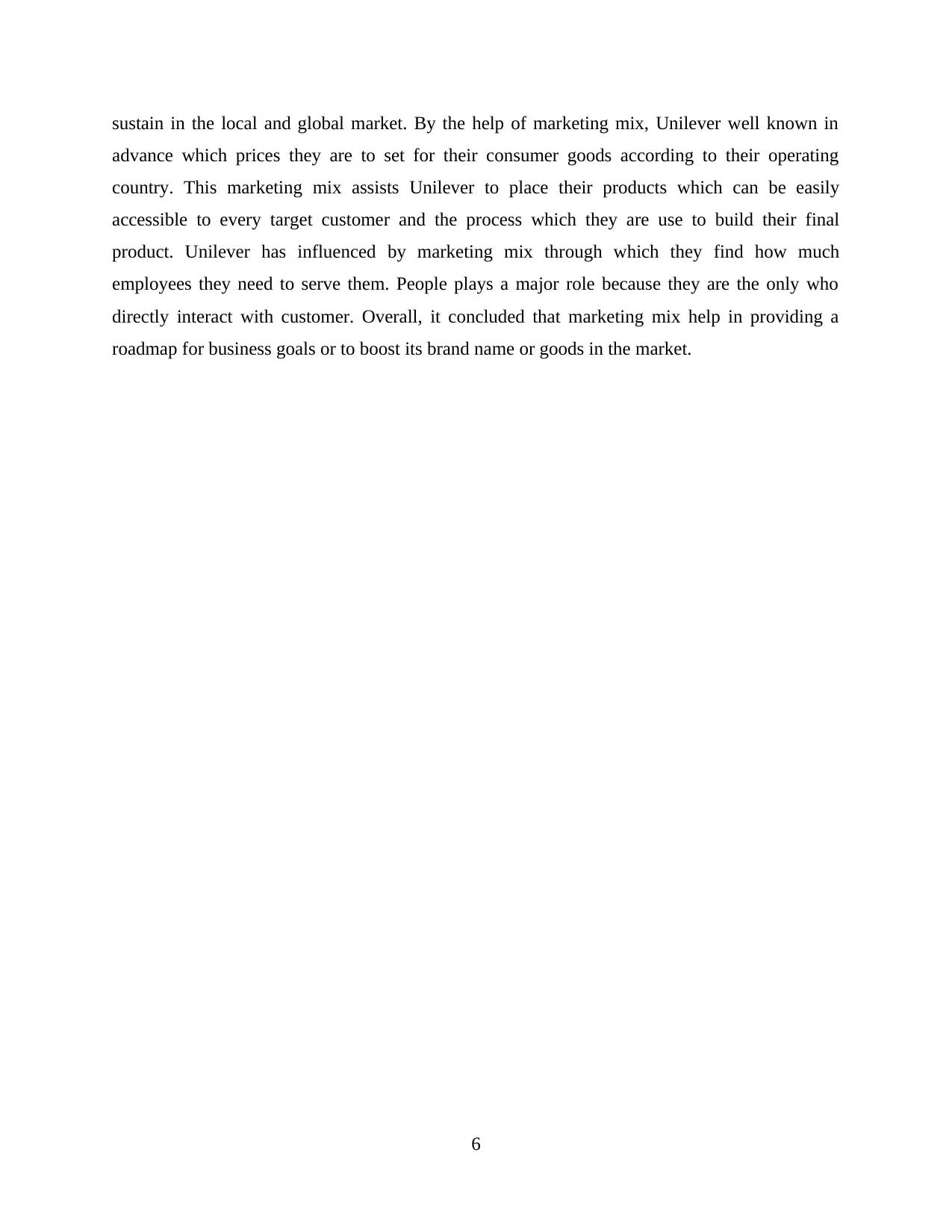
sustain in the local and global market. By the help of marketing mix, Unilever well known in
advance which prices they are to set for their consumer goods according to their operating
country. This marketing mix assists Unilever to place their products which can be easily
accessible to every target customer and the process which they are use to build their final
product. Unilever has influenced by marketing mix through which they find how much
employees they need to serve them. People plays a major role because they are the only who
directly interact with customer. Overall, it concluded that marketing mix help in providing a
roadmap for business goals or to boost its brand name or goods in the market.
6
advance which prices they are to set for their consumer goods according to their operating
country. This marketing mix assists Unilever to place their products which can be easily
accessible to every target customer and the process which they are use to build their final
product. Unilever has influenced by marketing mix through which they find how much
employees they need to serve them. People plays a major role because they are the only who
directly interact with customer. Overall, it concluded that marketing mix help in providing a
roadmap for business goals or to boost its brand name or goods in the market.
6

REFERENCES
Batat, W., 2022. The death of the traditional marketing mix (7Ps) and the rise of the experiential
marketing mix (7Es). In Strategies for the Digital Customer Experience (pp. 178-194).
Edward Elgar Publishing.
Chamberlin-Kim, J. and Wells, J.C., 2019. Alternative teacher preparation programs:
Examination through a marketing lens. Rural Special Education Quarterly. 38(3).
pp.137-150.
Fraser-Arnott, M., 2020. The marketing mix in parliamentary library websites. Journal of Library
Administration. 60(8). pp.875-888.
Gulia, A. and Marwah, G., 2022. MARKETING MIX AMID CHANGING CONSUMER
BEHAVIOUR DURING PANDEMIC. NEW PERSPECTIVES ON COMMERCE &
MANAGEMENT VOLUME-1, p.224.
Kumar, S. and Almoula, T.S., 2020. A comparative study of customer service level based on
service marketing mix (7Ps) in selected public and private sector banks in Bhopal, MP,
India, by using mystery shopping as a tool. International Journal of Financial Services
Management. 10(3). pp.239-267.
Lim, W.M. and De Run, E.C., 2020. Strategic brand management for higher education
institutions with graduate degree programs: empirical insights from the higher education
marketing mix. Journal of Strategic Marketing. 28(3). pp.225-245.
Moshtaghi, M.H. and Mirzaei, A., 2021. Related Factors of Patients' Preference in Choosing
Farhikhtegan Hospital based on the Mixed Marketing Model. Health Information
Management. 18(3). pp.117-123.
Payahour, M. and Asgari, G., 2020. Presenting a Marketing Mix Model for Development of
Tourism Industry in Iran. Journal of Business Management Perspective. 19(41). pp.119-
136.
Sopasoap, P. and et.al., 2021. SERVICE MARKETING MIX AND SERVICE QUALITY
INFLUENCING CUSTOMERS’SATISFACTION IN USING 7-ELEVEN
CONVENIENT STORES IN BANGKOK AND METROPOLITAN AREA. RMUTT
Global Business Accounting and Finance Review. 4(2).
Wang, J., and et.al., 2022. Social network customer relationship management for orchestras: a
case study on Hong Kong philharmonic orchestra. In Social Customer Relationship
Management (Social-CRM) in the Era of Web 4.0 (pp. 250-268). IGI global.
7
Batat, W., 2022. The death of the traditional marketing mix (7Ps) and the rise of the experiential
marketing mix (7Es). In Strategies for the Digital Customer Experience (pp. 178-194).
Edward Elgar Publishing.
Chamberlin-Kim, J. and Wells, J.C., 2019. Alternative teacher preparation programs:
Examination through a marketing lens. Rural Special Education Quarterly. 38(3).
pp.137-150.
Fraser-Arnott, M., 2020. The marketing mix in parliamentary library websites. Journal of Library
Administration. 60(8). pp.875-888.
Gulia, A. and Marwah, G., 2022. MARKETING MIX AMID CHANGING CONSUMER
BEHAVIOUR DURING PANDEMIC. NEW PERSPECTIVES ON COMMERCE &
MANAGEMENT VOLUME-1, p.224.
Kumar, S. and Almoula, T.S., 2020. A comparative study of customer service level based on
service marketing mix (7Ps) in selected public and private sector banks in Bhopal, MP,
India, by using mystery shopping as a tool. International Journal of Financial Services
Management. 10(3). pp.239-267.
Lim, W.M. and De Run, E.C., 2020. Strategic brand management for higher education
institutions with graduate degree programs: empirical insights from the higher education
marketing mix. Journal of Strategic Marketing. 28(3). pp.225-245.
Moshtaghi, M.H. and Mirzaei, A., 2021. Related Factors of Patients' Preference in Choosing
Farhikhtegan Hospital based on the Mixed Marketing Model. Health Information
Management. 18(3). pp.117-123.
Payahour, M. and Asgari, G., 2020. Presenting a Marketing Mix Model for Development of
Tourism Industry in Iran. Journal of Business Management Perspective. 19(41). pp.119-
136.
Sopasoap, P. and et.al., 2021. SERVICE MARKETING MIX AND SERVICE QUALITY
INFLUENCING CUSTOMERS’SATISFACTION IN USING 7-ELEVEN
CONVENIENT STORES IN BANGKOK AND METROPOLITAN AREA. RMUTT
Global Business Accounting and Finance Review. 4(2).
Wang, J., and et.al., 2022. Social network customer relationship management for orchestras: a
case study on Hong Kong philharmonic orchestra. In Social Customer Relationship
Management (Social-CRM) in the Era of Web 4.0 (pp. 250-268). IGI global.
7
⊘ This is a preview!⊘
Do you want full access?
Subscribe today to unlock all pages.

Trusted by 1+ million students worldwide
1 out of 9
Related Documents
Your All-in-One AI-Powered Toolkit for Academic Success.
+13062052269
info@desklib.com
Available 24*7 on WhatsApp / Email
![[object Object]](/_next/static/media/star-bottom.7253800d.svg)
Unlock your academic potential
Copyright © 2020–2025 A2Z Services. All Rights Reserved. Developed and managed by ZUCOL.




